|
|
A Week of Events
The First to Arrive
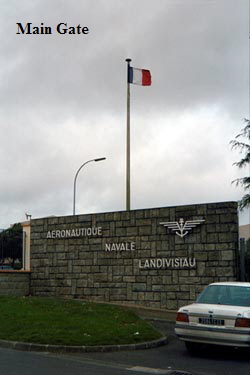 Monday morning, 29 November 1999, I called out to the base and talked to LtCdr GILLIOT. He invited me to come on out and call him again from the main gate. He personally came down to get the base clearance straight with the security for the visiting Americans. I was the first American to show up, and he wanted it to be the only time he had to come down and clear people through the process. When we got back to their administration offices, just across a small street/parking area from Hangar 4 where their maintenance spaces were, he gave me a cook's tour of the area. He introduced me to a couple dozen people whose names I promptly forgot, and left me with a cup of strong, black coffee and the record keepers and their logbooks for each aircraft. Monday morning, 29 November 1999, I called out to the base and talked to LtCdr GILLIOT. He invited me to come on out and call him again from the main gate. He personally came down to get the base clearance straight with the security for the visiting Americans. I was the first American to show up, and he wanted it to be the only time he had to come down and clear people through the process. When we got back to their administration offices, just across a small street/parking area from Hangar 4 where their maintenance spaces were, he gave me a cook's tour of the area. He introduced me to a couple dozen people whose names I promptly forgot, and left me with a cup of strong, black coffee and the record keepers and their logbooks for each aircraft.
35 Years of the French F-8
As mentioned, the French Navy bought 42 F-8E(FN) aircraft in 1964. In the following 35 years, they lost only six aircraft in Class A accidents, where the aircraft was a total loss. And in only 4 cases did the pilot lose his life. This has to be one of the best safety records for any aircraft anywhere, anytime. That doesn't mean they still had 36 aircraft to fly. There were accidents/incidents where the damage was major, but repairable. However due to the location of the wreckage, or for some other reason, they decided not to repair it, but to strip it down and use the good parts as spares, and declare the hulk to be what the US Navy calls a "category strike". There were several of these hulks behind a row of trees across the parking lot from the hangar, and that was a sad sight.
Squadron 12F had just come back from their last shipboard deployment aboard the carrier FOCH during the last part of October. At the completion of this short deployment off the Atlantic coast, the last arrested landing for an F-8 Crusader was made in Aircraft #34 by L.V. (Lt) Denis at 1,245 hrs. local time on 28 October. The last catapult launch was made that same date at 1,745 hrs. in Aircraft #11 by LtCdr GILLIOT, the squadron C.O. Their last extended deployment had been in March, again aboard FOCH, to the Adriatic Sea where they flew day and night missions in support of bombing raids over Kosovo. I couldn't find out how many aircraft or pilots they had aboard, nor the duration of the deployment or the total number of missions they flew, but they could verify that the Crusaders were being utilized in their intended mission right up to the end of their service life. At the end of this deployment, Aircraft #35 was flown from the carrier in the Adriatic, non-stop, non-IFR, to the base at Landivisiau, a flight lasting 2 hours 35 minutes.
Following their final deployment in October, they began downsizing the squadron, transferring pilots into other billets and transporting the aircraft to the long-term storage yard at B.A.N. Cuers-Pierrefeu, in the south of France. At the end of November, there were five aircraft and six pilots still assigned to the squadron, with a sixth aircraft in non-flying status, being used as a "hangar queen", which is a parts bin for replacement components that might be required to keep the others in "up" status.
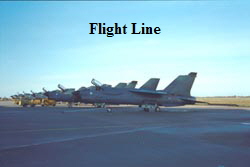 The five aircraft still flying were #7, #10, #11, #34 and #39 (these are the "sequence of fabrication" numbers assigned to each aircraft as it came down the assembly line in Dallas). The French almost never used the BuNo. designation that the US Navy used. Each of these aircraft had gone through what they called their "prolongement" program. In conjunction with the original Vought design limits, service life restrictions on the aircraft, and the US Navy Depot Engineering at NAS Norfolk and North Island, they had developed a modification program to reinforce and/or replace those structural components, primarily in the wing, which were deemed to be fatigue critical. In addition, when the US Navy retired the last of their F-8J aircraft, which have virtually the same wing as the F-8E(FN), the French bought some of these aircraft which had accumulated the lowest number of flight hours. The wings of these aircraft were removed from the F-8J's and installed on the French aircraft which were then re-designated F-8P (for "prolongement"). The five aircraft still flying were #7, #10, #11, #34 and #39 (these are the "sequence of fabrication" numbers assigned to each aircraft as it came down the assembly line in Dallas). The French almost never used the BuNo. designation that the US Navy used. Each of these aircraft had gone through what they called their "prolongement" program. In conjunction with the original Vought design limits, service life restrictions on the aircraft, and the US Navy Depot Engineering at NAS Norfolk and North Island, they had developed a modification program to reinforce and/or replace those structural components, primarily in the wing, which were deemed to be fatigue critical. In addition, when the US Navy retired the last of their F-8J aircraft, which have virtually the same wing as the F-8E(FN), the French bought some of these aircraft which had accumulated the lowest number of flight hours. The wings of these aircraft were removed from the F-8J's and installed on the French aircraft which were then re-designated F-8P (for "prolongement").
According to the logbooks that they showed me for these five aircraft, they had accumulated some fantastic statistics. For instance, #7 had accumulated a total of 5,986 flight hours, #10 had 5,542, #11 had 5,696, #34 had 4,610, and #39 had 5,053. Aircraft #39 logged 1,023 catapult launches, and #7 a total of 1,438 arrested landings, with the other four aircraft logging between 860 and 950 catapults and in excess of 1,100 arrestments. It should be noted that all of the air stations in this part of France are equipped with field arresting gear. Due to the severe weather conditions, a significant number of field landings utilize this arresting gear, thus the much higher number of arrestments than catapults.
Since these numbers of catapult launches far exceed the design limits of the original aircraft, the French established a requirement for a dye penetrant inspection for the catapult keels after every 20 "cat shots" in excess of 1000. They did not report any suspect cracks in any of the catapult keels.
The French were very considerate in digging out the information that I was looking for, and understood why we wanted the latest data for the last Crusaders that were flying. They seemed to feel that we were a part of this history-making event that was taking place - "the last flight of the Crusaders". Several times during the rest of the weekend, one or the other of these maintenance record keepers would see me somewhere around the spaces, and come up and want to talk. They were most interested in the USN Crusaders and particularly how they had made out in combat in Viet Nam (or Indochina as they called it).
Air Show Practice
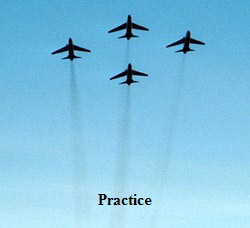 Somewhere during our several hours of working on the records, one of the CPO,s came in and said the flight team was getting ready to fly a practice run of their air show for Friday's ceremony and asked if I wanted to watch. "Yes, indeed!" I replied. I got my big coat and fur-lined cap and went out and stood on the tarmac ramp for an hour while they taxied their four-plane team. They took off in pairs and went through their paces. It was all low-level flying, all within sight of the base, a very low-key demonstration, but still very professional. The actual air show part lasted about 20 minutes. Somewhere during our several hours of working on the records, one of the CPO,s came in and said the flight team was getting ready to fly a practice run of their air show for Friday's ceremony and asked if I wanted to watch. "Yes, indeed!" I replied. I got my big coat and fur-lined cap and went out and stood on the tarmac ramp for an hour while they taxied their four-plane team. They took off in pairs and went through their paces. It was all low-level flying, all within sight of the base, a very low-key demonstration, but still very professional. The actual air show part lasted about 20 minutes.
Tuesday morning, 30 November 1999, the flight team scheduled another rehearsal of their performance, and by this time there were a few more Americans here. On the final pass over the flight line, where we were all gathered, the four aircraft were arranged in a diamond formation as they came over with the afterburners engaged, at about 500 feet altitude and at about 500 knots airspeed. The noise and blast of it shook the buildings and we could feel the heat of the exhaust from the engines. It was a much more impressive finish to the show than on Monday.
Wednesday, 1 December 1999, I went for a drive toward the westernmost point of France.
“Beer Call” at the Greenwood Pub in Landivisiau
I already had checked out where the Greenwood Pub was located in Landivisiau, so I headed there about 4:15 p.m. on Wednesday, for “Beer Call”, to meet and recall stories with the other visiting Americans. There was no street parking available in the area so the people coming from Brest and other points had a hard time finding places to leave their cars. A couple of us stood out on the sidewalk pointing them to an off-street parking area about half a block away, giving me a chance to meet lots of people that I hadn't met before. Pretty soon Joe Engle and his wife showed up. They'd gotten turned around again coming out of Brest, and had to ask directions again, only this time no police escort.
The party was a great success. There was all the beer and wine anybody could want, and a never ending supply of unique hors d'oeuvres. 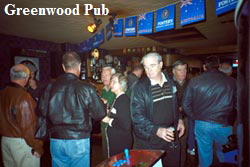 Most of the Americans were there. Most of them I'd not met before and they were most interested to discover that neither Vought/LTV, nor the French Navy, had arranged for more of the manufacturers' personnel to be there. Quite a number of them asked about the company reps who had worked with their squadrons "way back when", people such as Fred Tappan, Andy Patterson, Mel Raffo, Jack Drechsler, Fred Glass, Roy Orsi, all "old timers". Everyone seemed to cluster into small groups and talk for a while and then dissolve and regroup into other small groups. Somewhere around 5:00 p.m., the C.O. made a small welcoming speech, and announced that he had a free souvenir for everybody, two of them if you wanted. He led the way out to his car, which was parked just outside the door in a no parking zone; in the trunk, he had several large boxes full of F-8 catapult holdback fittings! It was a fun evening, and since a number of the folks had only arrived in town that the day, and hadn't recovered from jet lag, the crowd started thinning out around 9:00 p.m., so we all began to clear out and head for our rooms. Most of the Americans were there. Most of them I'd not met before and they were most interested to discover that neither Vought/LTV, nor the French Navy, had arranged for more of the manufacturers' personnel to be there. Quite a number of them asked about the company reps who had worked with their squadrons "way back when", people such as Fred Tappan, Andy Patterson, Mel Raffo, Jack Drechsler, Fred Glass, Roy Orsi, all "old timers". Everyone seemed to cluster into small groups and talk for a while and then dissolve and regroup into other small groups. Somewhere around 5:00 p.m., the C.O. made a small welcoming speech, and announced that he had a free souvenir for everybody, two of them if you wanted. He led the way out to his car, which was parked just outside the door in a no parking zone; in the trunk, he had several large boxes full of F-8 catapult holdback fittings! It was a fun evening, and since a number of the folks had only arrived in town that the day, and hadn't recovered from jet lag, the crowd started thinning out around 9:00 p.m., so we all began to clear out and head for our rooms.
Final Practice
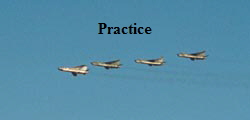 Thursday morning, 2 December 1999, was cool again, but only partly cloudy with clear spots here and there. I headed out to the base about 9:00 a.m. As I was driving out of town, I saw a sliver of the sunrise between the horizon and the cloud cover. When I got out to the base, the place was crawling with what appeared to be all 182 of the Americans who had signed to come over, and a bunch more Frenchmen than I'd seen around the place before. Most were gathered on the ramp where all six aircraft were parked, just like the good old days. A little after 10:00 a.m. the four pilots came out and got a rousing ovation. They were all suited up to fly another practice run for their air show. The four were: the Commanding Officer, Capitaine de Fregate (Lt.Cdr) Antoine GUILLOT, the Executive Officer, Capitaine de Fregate Paul Emmanuel SIDO, Lieutenant de Vaisseau (Lt) Eric BERTRN, and Ensegne de Vaisseau (Lt.jg) Stephane AUBRY. The two junior officers looked like they should still be in high school, too young to be flying anything but kites. But they did a beautiful job of flying wing on GUILLOT and SIDO. Thursday morning, 2 December 1999, was cool again, but only partly cloudy with clear spots here and there. I headed out to the base about 9:00 a.m. As I was driving out of town, I saw a sliver of the sunrise between the horizon and the cloud cover. When I got out to the base, the place was crawling with what appeared to be all 182 of the Americans who had signed to come over, and a bunch more Frenchmen than I'd seen around the place before. Most were gathered on the ramp where all six aircraft were parked, just like the good old days. A little after 10:00 a.m. the four pilots came out and got a rousing ovation. They were all suited up to fly another practice run for their air show. The four were: the Commanding Officer, Capitaine de Fregate (Lt.Cdr) Antoine GUILLOT, the Executive Officer, Capitaine de Fregate Paul Emmanuel SIDO, Lieutenant de Vaisseau (Lt) Eric BERTRN, and Ensegne de Vaisseau (Lt.jg) Stephane AUBRY. The two junior officers looked like they should still be in high school, too young to be flying anything but kites. But they did a beautiful job of flying wing on GUILLOT and SIDO.
This turned out to be the best weather they had for flying all week. Alter the practice run through the air show routine the pilots received another rousing ovation and remained for lots of photos and autographs. The old American pilots, went to the flight line and looked at the planes close-up. Several of them climbed up into the cockpits for one more "sit". Several more tried but couldn't get their foot up on that first step. The aircraft were light on fuel, so the nose gear was not fully compressed, therefore a mighty big step for those old legs. A couple of the guys made it with the help of a shove on the butt, but for others, that wasn't enough! I was somewhat concerned somebody was going to fall off a ladder and break a leg or something worse, but fortunately nobody did. It was a wonderfully delightful experience.
After a while people started wandering back into the squadron spaces to warm up. The French were selling all sorts of souvenirs, cocktail glasses etched with an F-8 silhouette and the words "Last flight of the Crusader - Witness - Landivisiau", tee-shirts, patches, decals, neckties, etc. After talking to a few of the guys for a while, I headed into town, found a little restaurant on a side street and had dinner. After dinner, I returned to the auberge for an hour and a half nap. I'd been reading my book about the battle for the Normandy beaches and spent some more time with that and my Michelin map, figuring the best way to get there and get around.
The Last Flight of the F-8
Friday, 3 December 1999, scheduled to be the "big" day of the festivities, dawned the worst weather since I've been here. The ceiling was down on the treetops and it was rainy and blustery. I left about 8:30 a.m. and ran into some pretty heavy showers on the way to the base. At the main gate, a tent was set up in the parking lot for the visitors to check in, and signs all along the streets lead us to the Squadron 12F hangar parking lot. I was not the first person there, lots of the Americans and French had already arrived. Never did figure out who they all were. Only a few were in uniform and most of them were civilians.
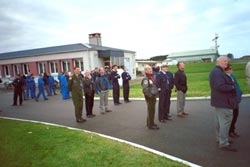 It didn't take long to find out that confusion was in complete control. With the weather as bad as it was, the Base Commander had come over and told GILLIOT that all the flying for the day was canceled. It wasn't long before one of the Admirals from Paris heard this and countermanded the order, but insisted that the flying would be done under the cloud cover, and within the boundaries of the base. This was not a big restriction, because that's what they'd been practicing all week. As the rain quit and the weather improved, there were a few spots of blue sky showing through the clouds. Around 10:30 a.m., the four pilots came out again, this time to a bigger ovation from a bigger crowd, fired up the aircraft, taxied out and took off in elements of two aircraft with afterburners blazing. The spots of blue sky got bigger, and about halfway through the show, half the overhead was bright blue. That didn't help the temperature, it was still very cold because of a stout north wind. Their flying was again impeccable. It didn't take long to find out that confusion was in complete control. With the weather as bad as it was, the Base Commander had come over and told GILLIOT that all the flying for the day was canceled. It wasn't long before one of the Admirals from Paris heard this and countermanded the order, but insisted that the flying would be done under the cloud cover, and within the boundaries of the base. This was not a big restriction, because that's what they'd been practicing all week. As the rain quit and the weather improved, there were a few spots of blue sky showing through the clouds. Around 10:30 a.m., the four pilots came out again, this time to a bigger ovation from a bigger crowd, fired up the aircraft, taxied out and took off in elements of two aircraft with afterburners blazing. The spots of blue sky got bigger, and about halfway through the show, half the overhead was bright blue. That didn't help the temperature, it was still very cold because of a stout north wind. Their flying was again impeccable. 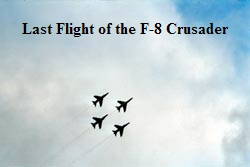 They formed up in their diamond formation and flew over the crowd at about 500 feet, at over 500 knots, with the oil cooler doors open and they were low enough so you could feel the heat from the afterburners. At that moment there wasn't a dry American eye in the crowd. I'd wager that every one of the American pilots was, in his mind's eye, sitting on the lap of one of the French pilots, flying that aircraft one more time. This performance was worth the cost of the entire trip just to be there for that moment, and to experience those emotions. They formed up in their diamond formation and flew over the crowd at about 500 feet, at over 500 knots, with the oil cooler doors open and they were low enough so you could feel the heat from the afterburners. At that moment there wasn't a dry American eye in the crowd. I'd wager that every one of the American pilots was, in his mind's eye, sitting on the lap of one of the French pilots, flying that aircraft one more time. This performance was worth the cost of the entire trip just to be there for that moment, and to experience those emotions.
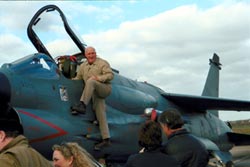 After the aircraft were back on the ramp everybody began walking around them, touching them and taking more pictures one final time. Clouds moved in and a light mist started falling, so it was announced that all the rest of the outdoor activities for the day were canceled. A planned memorial mass for the four French pilots, with arrangements to include all the USN/MC pilots, who had lost their lives in F-8 accidents, was canceled also. There were several displays set up in Hangar 4 and we wandered through those for a while. After the aircraft were back on the ramp everybody began walking around them, touching them and taking more pictures one final time. Clouds moved in and a light mist started falling, so it was announced that all the rest of the outdoor activities for the day were canceled. A planned memorial mass for the four French pilots, with arrangements to include all the USN/MC pilots, who had lost their lives in F-8 accidents, was canceled also. There were several displays set up in Hangar 4 and we wandered through those for a while.
The After Show Luncheon
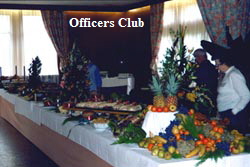 At 12:00 noon, everybody migrated to the Officer's Club for a buffet luncheon, the likes of which one seldom sees. They had five tables, each about 20-25 feet long, loaded down with a fantastic assortment of food: cold baked salmon, roast beef, ham, mutton, all kinds of salads, hors d'oeuvres, various types of breads, and a couple of bars, well stocked, well manned and well used. As you can imagine, very few people were in a hurry to leave. We visited with three young French pilots who had recently returned from their advanced jet training at NAS Meridian, Mississippi. They thoroughly enjoyed their 9-month stay in the US, saw quite a bit of the country, and were sorry they were too late in their career to fly the Crusader. One of them mentioned that his father had worked on the Invasion Museum Building near Utah Beach, and mentioned several places that he thought would be interesting for us to visit. At 12:00 noon, everybody migrated to the Officer's Club for a buffet luncheon, the likes of which one seldom sees. They had five tables, each about 20-25 feet long, loaded down with a fantastic assortment of food: cold baked salmon, roast beef, ham, mutton, all kinds of salads, hors d'oeuvres, various types of breads, and a couple of bars, well stocked, well manned and well used. As you can imagine, very few people were in a hurry to leave. We visited with three young French pilots who had recently returned from their advanced jet training at NAS Meridian, Mississippi. They thoroughly enjoyed their 9-month stay in the US, saw quite a bit of the country, and were sorry they were too late in their career to fly the Crusader. One of them mentioned that his father had worked on the Invasion Museum Building near Utah Beach, and mentioned several places that he thought would be interesting for us to visit.
Yves GOUPIL
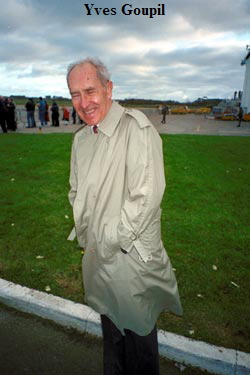 For me, one of the highlights of the day, were the conversations I had with Yves GOUPIL. Yves was the first French Navy pilot to qualify as an F-8 pilot. A group of 12 French pilots was assigned to VF-l74 at NAS Cecil Field, Jacksonville, Florida during 1964 to train as the core of the two French squadrons that would fly the F-8E(FN). Yves was assigned as the Commanding Officer of the squadrons designated 12F and 14F. Yves was with us at NATC Patuxant River, Maryland between July and October 1964, and on board the USS Shangri-La for the Service Tests and Carrier Suitability Tests for the aircraft. We worked very closely during that time, and became very good friends. I lost contact with him after we came back from our year in France in 1966. Once in a while, I saw his name in aviation magazine stories about the French Navy, and knew that he had moved up to a high rank. When I started getting e-mails about this event, one letter from the squadron described a book about the French F-8's. The letter also noted that the book contained a Foreword by Vice Admiral d'Escadre (Vice Admiral of the Fleet) Yves GOUPIL, so he had certainly risen to a high rank. For me, one of the highlights of the day, were the conversations I had with Yves GOUPIL. Yves was the first French Navy pilot to qualify as an F-8 pilot. A group of 12 French pilots was assigned to VF-l74 at NAS Cecil Field, Jacksonville, Florida during 1964 to train as the core of the two French squadrons that would fly the F-8E(FN). Yves was assigned as the Commanding Officer of the squadrons designated 12F and 14F. Yves was with us at NATC Patuxant River, Maryland between July and October 1964, and on board the USS Shangri-La for the Service Tests and Carrier Suitability Tests for the aircraft. We worked very closely during that time, and became very good friends. I lost contact with him after we came back from our year in France in 1966. Once in a while, I saw his name in aviation magazine stories about the French Navy, and knew that he had moved up to a high rank. When I started getting e-mails about this event, one letter from the squadron described a book about the French F-8's. The letter also noted that the book contained a Foreword by Vice Admiral d'Escadre (Vice Admiral of the Fleet) Yves GOUPIL, so he had certainly risen to a high rank.
Yves hasn't changed a lot, still the friendly guy he was 35 years ago. He told me about how much the French pilots enjoyed flying the aircraft, and about the good safety record it enjoyed. He also told me about his last flight in an F8. It was on the 25th anniversary of his first flight in VF-174 in 1964. He has a picture of himself in the cockpit of the aircraft, wearing his flight helmet, painted especially with his four-star rank insignia. I thoroughly enjoyed talking with him about the "good old days".
With the air show over, the last scheduled event was the gathering at the castle later that evening. I then had some more sight seeing to complete and a trip home.
An Evening at the “Castle”
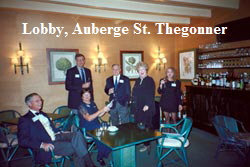 After the air show on Friday, 3 December 1999, I went back to the auberge, took a short nap, got my stuff together for the trip into Normandy the following day, and began getting ready for the big soiree at the "castle". When I got down to the lobby of the auberge, the place was loaded with gentlemen in their blue blazers with their "Go Fast" buttons and gray flannels, and the ladies in their fine dresses. Dick Moller and Cindi were there. Dick had a U.S. flag motif necktie on that was drawing all kinds of comments. The "castle", actually called Chateau Brezal, is a large country estate built in 1782 that now belongs to the Commander of the French Navy. The sign out front says "It's available for large dinner parties". This one qualified; there were some 500-600 people. There were several open bars, and waiters wandering around with trays of drinks, so with everybody milling around visiting first one group, then another, the noise level was pretty high. After the air show on Friday, 3 December 1999, I went back to the auberge, took a short nap, got my stuff together for the trip into Normandy the following day, and began getting ready for the big soiree at the "castle". When I got down to the lobby of the auberge, the place was loaded with gentlemen in their blue blazers with their "Go Fast" buttons and gray flannels, and the ladies in their fine dresses. Dick Moller and Cindi were there. Dick had a U.S. flag motif necktie on that was drawing all kinds of comments. The "castle", actually called Chateau Brezal, is a large country estate built in 1782 that now belongs to the Commander of the French Navy. The sign out front says "It's available for large dinner parties". This one qualified; there were some 500-600 people. There were several open bars, and waiters wandering around with trays of drinks, so with everybody milling around visiting first one group, then another, the noise level was pretty high.
I found out that during WW II, Field Marshal Erwin Rummel used the Chateau Brezal as his headquarters while in command along the "Atlantic Wall". Later, when the Allies had secured the invasion beachhead, General George Patton, and later General Dwight Eisenhower, used it for the same purpose. The Chateau Brezal did not suffer much, if any, damage during the war.
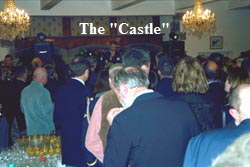 The evening program consisted of a series of toasts, presentations, acknowledgments and short speeches. I was not near the front of the crowd, and the noise level was pretty high, so I didn't hear all of what was going on, but the ones I did hear, were very interesting. One of the American pilots, Ed Shriver Captain USNR, who had been a member of VF-l54, the very first USN squadron to deploy the F8U-l's on board USS Hankock in February 1958, presented a plaque to GUILLOT inscribed "From the first to the last". Yves GOUPIL made a short speech that included a comment concerning a decal that Vought put out; The evening program consisted of a series of toasts, presentations, acknowledgments and short speeches. I was not near the front of the crowd, and the noise level was pretty high, so I didn't hear all of what was going on, but the ones I did hear, were very interesting. One of the American pilots, Ed Shriver Captain USNR, who had been a member of VF-l54, the very first USN squadron to deploy the F8U-l's on board USS Hankock in February 1958, presented a plaque to GUILLOT inscribed "From the first to the last". Yves GOUPIL made a short speech that included a comment concerning a decal that Vought put out; 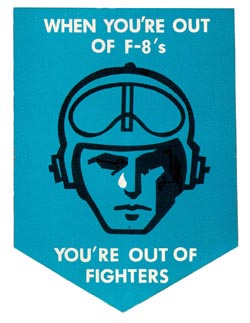 "When you're out of F-8's you're out of fighters". His comment was to the effect that that phrase is not quite true, "We're all still fighters"! That remark received a rousing ovation. Larry Durbin thanked the French for their hospitality and gave each of the French pilots a "Thousand Mile an Hour" pin and a set of the "Go Fast" blazer buttons. "When you're out of F-8's you're out of fighters". His comment was to the effect that that phrase is not quite true, "We're all still fighters"! That remark received a rousing ovation. Larry Durbin thanked the French for their hospitality and gave each of the French pilots a "Thousand Mile an Hour" pin and a set of the "Go Fast" blazer buttons.
Shortly thereafter, the feeding frenzy began. This was a grown-up version of the lunch we'd had at the O-Club. More of the same, much more. Even after several trips to the serving tables we were not able to sample everything. There were four or five large dining areas, several of them on the second level. There was no way you could see everybody. We were seated at tables of eight and probably had 20 tables in our area. After dinner we found GUILLOT, congratulated him again on first class festivities, thanked him for letting us be a part of it, and walked out into the rain, through a muddy parking lot to find the car.
|